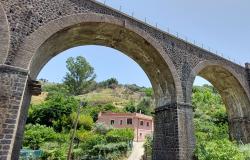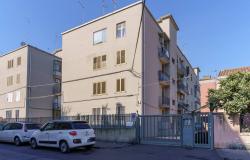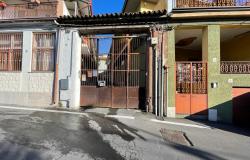I nearly cried back in Cardiff, Wales, when the men from the removal company started packing my books: I watched, horrified, as they took one from this shelf, two or three from that, then half a dozen from another and piled them all into the same box.
“But they’re in categories!” I wailed pathetically, trying to imagine how I would ever be able to re-sort them once they arrived in Sicily.
“Sorry, love, we have to pack them according to size”, replied the elder of the two. “Can we have a cup of tea, love?”
 Thus was the fate of my most precious possessions, which I would not see again for a good eight weeks, taken out of my hands. My belongings were sent to Sicily by sea, whilst Simi the dog and I fearlessly flew ahead.
Thus was the fate of my most precious possessions, which I would not see again for a good eight weeks, taken out of my hands. My belongings were sent to Sicily by sea, whilst Simi the dog and I fearlessly flew ahead.
When we arrived in Modica, a friend lent us a tiny, traditional house in Modica Bassa, the historic centre of the town and we lived in it contentedly for just over five weeks. If you take a look at this traditionally Sicilian way of securing a door, you will see why I felt completely safe there!
 My next task was to find somewhere to rent permanently and I managed this almost immediately, finding an apartment through a friend. The paperwork for the rental was completed speedily [by Sicilian standards] but I couldn’t move in until I had signed contracts for the provision of water, electricity and gas and for these, I had read, I would need a certificate of residence in Modica.
My next task was to find somewhere to rent permanently and I managed this almost immediately, finding an apartment through a friend. The paperwork for the rental was completed speedily [by Sicilian standards] but I couldn’t move in until I had signed contracts for the provision of water, electricity and gas and for these, I had read, I would need a certificate of residence in Modica.
An EU citizen does not, in theory, need any document other than a valid passport in order to remain in Italy or any other EU country. But in Italy even an Italian citizen needs proof of residence in order to obtain any utilities or town services, so it is quite useless to argue about your “rights” for there are rights and there is Italian bureaucracy and, as Kipling said, “ne’er the twain shall meet”.
 So, one fine day in June 2005, my friend Linda [who has lived here for 40 years] and I began to negotiate the bureaucratic trail: what an EU citizen needs is the Carta CEE [a sort of “permission to stay”] and this is obtained from the Questura [main police station] of your area. Visit any main police station in Italy in the morning and you will see a queue of non-EU citizens waiting to enter and plead their case to stay.
So, one fine day in June 2005, my friend Linda [who has lived here for 40 years] and I began to negotiate the bureaucratic trail: what an EU citizen needs is the Carta CEE [a sort of “permission to stay”] and this is obtained from the Questura [main police station] of your area. Visit any main police station in Italy in the morning and you will see a queue of non-EU citizens waiting to enter and plead their case to stay.
Another friend had, through a contact in the Questura, made an appointment for us with a police inspector and I tried not to show my guilty feelings as we walked past the thirty or so North Africans standing in the already stifling heat. [I’m British, you see – the old fair play and all that.] All my documents were efficiently examined, noisily stamped – it’s not a real Italian office unless everything is stamped with a flourish – and filed away. Then I was issued with a receipt for my application and this, I thought, would enable me to obtain the town residence certificate.
Next stop was the Town Hall where we were firmly told that there was no way that any certificate of residence could be issued before I received the “real” Carta CEE and I would need a codice fiscale [similar to a British National Insurance number] as well. We begged, cajoled and Linda became very assertive but there was no budging the clerks on this. My plea of “But I won’t be able to move in” met with that maddening Sicilian gesture of outstretched hands and shrugging shoulders and I swear I heard the woman clerk utter “Pazienza”.
 At the Agenzia Entrate we again met with resistance, though this barricade seemed more breachable. “No, you’re not Italian, you have no right and there is no precedent” was the first response. “But I’m an EU citizen”, said I “and I can’t go back because I have nothing in the UK.” Linda, whose surname is Churchill, had meanwhile decided to live up to it and made it quite clear that this time we were not going to be moved and, after the clerk had deliberated for what seemed like eternity with a manager and other colleagues, we were told that I could be issued with the codice fiscale. And that, I later discovered, is the magic key, for with it I was able to obtain the contracts. In Italy you need a codice fiscale to carry out the simplest transactions and you eventually receive a little card with the number on it, which everyone carries around.
At the Agenzia Entrate we again met with resistance, though this barricade seemed more breachable. “No, you’re not Italian, you have no right and there is no precedent” was the first response. “But I’m an EU citizen”, said I “and I can’t go back because I have nothing in the UK.” Linda, whose surname is Churchill, had meanwhile decided to live up to it and made it quite clear that this time we were not going to be moved and, after the clerk had deliberated for what seemed like eternity with a manager and other colleagues, we were told that I could be issued with the codice fiscale. And that, I later discovered, is the magic key, for with it I was able to obtain the contracts. In Italy you need a codice fiscale to carry out the simplest transactions and you eventually receive a little card with the number on it, which everyone carries around.
After about three weeks I received the “real” Carta CEE and was finally allowed to register with the Town Hall – mostly so that I could have the privilege of being sent a refuse collection bill – and the clerks were all smiles when I went back to do this. You have to remember that they are only administering a system and often their lack of eye contact with you and curt manner mask the fact that they really hate saying “No”!
 A few days after that, I was honoured with the statutory visitation from a vigile [local policeman]. This is to ensure that you live where you say you live and are not destitute. You are not supposed to know when he is coming but I had a fair idea as the Town Hall clerk had asked me whether I preferred morning or afternoon, Wednesday or Friday and between what hours. I used to think this was unnecessary bureaucracy at work again but now it doesn’t seem such a bad idea, for in this way at least the Italians have some idea who is in their country. My visit lasted exactly two seconds for, once the vigile saw the numerous boxes of books which had by then arrived, he was satisfied that I had some possessions!
A few days after that, I was honoured with the statutory visitation from a vigile [local policeman]. This is to ensure that you live where you say you live and are not destitute. You are not supposed to know when he is coming but I had a fair idea as the Town Hall clerk had asked me whether I preferred morning or afternoon, Wednesday or Friday and between what hours. I used to think this was unnecessary bureaucracy at work again but now it doesn’t seem such a bad idea, for in this way at least the Italians have some idea who is in their country. My visit lasted exactly two seconds for, once the vigile saw the numerous boxes of books which had by then arrived, he was satisfied that I had some possessions!
Note: Italy simplified the procedures for permission to stay in 2007 and I do not have the experience to comment on the changes. The rules are, of course, different for American and non-EU citizens.








